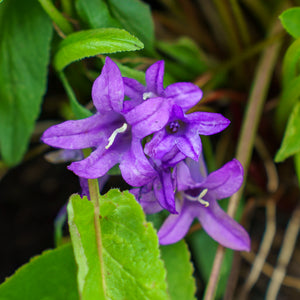The Campanula Guide
Campanula, commonly known as bellflower, is a charming perennial that adds a burst of color and delicate shape to gardens and containers alike. With bell- or star-shaped flowers in shades of blue, purple, and white, Campanula offers a classic cottage garden look that also performs beautifully in modern landscapes. These long-blooming plants are easy to grow, attract pollinators, and bring a light, airy texture to garden beds. Here's everything you need to know about growing and caring for Campanula.
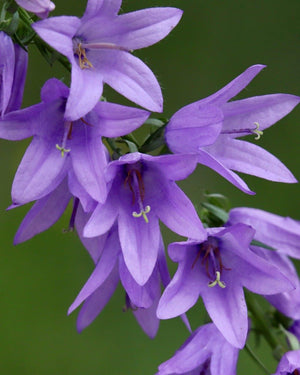
About
Campanula is a diverse genus of flowering plants in the Campanulaceae family, native to temperate regions across the Northern Hemisphere. With over 300 species, Campanulas range from low-growing ground covers to upright clump-forming varieties. They're best known for their bell-shaped flowers, although some types feature open, star-like blooms.
Popular varieties include Campanula portenschlagiana 'Get Mee Purple', a compact, mound-forming type great for containers; Campanula carpatica 'Blue Clips', which produces deep blue flowers atop low-growing foliage; and Campanula glomerata 'Freya', a clump-forming species with dense clusters of rich purple flowers. Campanula poscharskyana 'Blue Waterfall' is a spreading variety perfect for cascading over walls or pots, while Campanula persicifolia 'Takion Blue' stands tall with upright stems covered in striking blue blooms.
Campanulas are beloved for their versatility, bloom duration, and ability to complement nearly any garden style. Most varieties are perennials that return year after year with proper care.
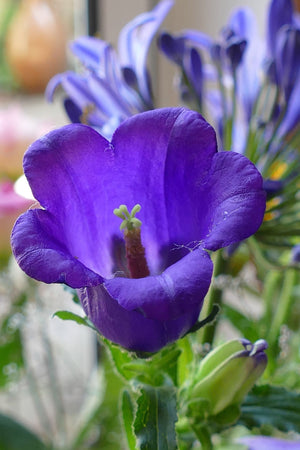
PLANTING
- USDA Hardiness Zones: Typically hardy in Zones 3–8, depending on the species.
- Soil: Prefers moist, well-drained soil enriched with organic matter. Tolerates a range of soil types as long as drainage is good.
- Sunlight: Most Campanula varieties thrive in full sun to partial shade. In hotter climates, some afternoon shade is beneficial.
- Watering: Water regularly during dry periods, especially while establishing. Mature plants are moderately drought-tolerant.
- Spacing: Space 10–24 inches apart, depending on variety, to allow good air circulation and spreading room.
- Planting Time: Best planted in spring or early fall to allow roots to establish before extreme temperatures.
To plant Campanula, prepare the soil by loosening it and adding compost or organic material. Dig a hole just deep enough for the root ball, backfill, and water thoroughly.

CARE
- Watering: Maintain consistent moisture, especially during the growing season, but avoid waterlogged soil.
- Fertilizing: Apply a balanced fertilizer in spring when new growth emerges and again after the first flush of blooms.
- Deadheading: Remove spent blooms regularly to encourage continuous flowering and a tidy appearance.
- Pruning: After flowering, shear back the plant by half to encourage reblooming and fresh growth.
- Dividing: Divide clumps every 3–4 years in spring or fall to rejuvenate plants and prevent overcrowding.
- Pests & Diseases: Generally pest-resistant, but may occasionally attract slugs or aphids. Watch for powdery mildew in humid conditions.
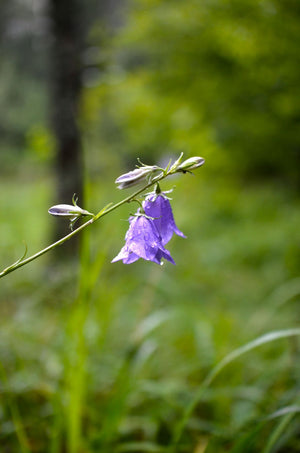
HOW TO USE
Campanula’s delicate blooms and wide range of forms make it suitable for many landscape uses:
- Borders & Edges: Compact varieties like Campanula carpatica 'Rapido Blue' are ideal for defining paths and bed edges.
- Rock Gardens: Low-growing types add seasonal color and texture between stones and in crevices.
- Containers & Window Boxes: Trailing varieties like Campanula poscharskyana 'Blue Waterfall' provide a spilling effect over container edges.
- Cottage Gardens: A staple for traditional cottage-style plantings with other soft, romantic bloomers.
- Pollinator Gardens: The bell-shaped flowers attract bees and butterflies, supporting local pollinator populations.
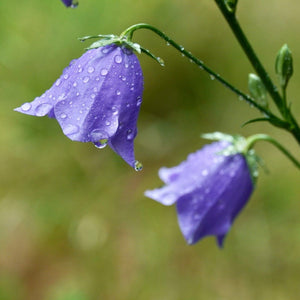
Common Questions
- Is Campanula a perennial? Yes, most Campanula species are hardy perennials that return and bloom year after year.
- Does Campanula come back every year? With proper care and suitable conditions, Campanula will reliably return each season.
- Is Campanula toxic to cats? Campanula is non-toxic to cats and safe for pet-friendly gardens.
- Is Campanula toxic to dogs? Campanula is not known to be toxic to dogs and is generally considered safe.
- Do deer eat Campanula? While not a primary target, Campanula may occasionally be browsed by deer.
- Does Campanula spread? Many species spread slowly via rhizomes or self-seeding. Some, like Campanula poscharskyana, spread more aggressively.
- How to deadhead Campanula? Use scissors or pruners to snip off faded flowers just above a leaf or bud to encourage more blooms.
- How to plant Campanula? Plant in well-drained soil in a sunny to partly shaded location. Water well after planting and mulch to retain moisture.
- Is Campanula invasive? Most types are well-behaved, though spreading varieties may naturalize over time if not monitored.
Conclusion
Campanula adds elegance and charm to any garden with its bell-shaped flowers and easygoing nature. Whether cascading over a rock wall, brightening a container, or lining a garden path, Campanula brings soft color and pollinator appeal to your landscape. With varieties like Campanula 'Sarastro', Campanula carpatica 'White Clips', and Campanula glomerata 'Genti White', you're sure to find the perfect type to suit your garden. Explore our selection and enjoy the timeless beauty of bellflowers.
The Campanula Collection
Sold Out
Sold Out
Sold Out




